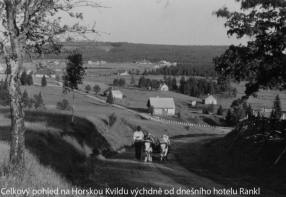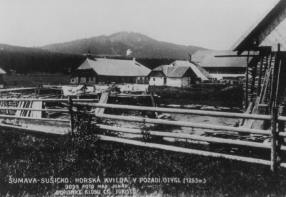HISTORY OF THE VILLAGE
The original settlement of wood-cutters with the scattered houses on the banks of the Hamerský stream is situated on the vast plain beneath Antýgl mountain in central part of the Šumava. The village got its attribute "Horská" (Mountainous) after the town of Kašperské Hory, as it historically belonged into its administration area. The village was founded in 1577, but the first written records about the settlement date back from the 14th century in connection with the Kašperské Hory branch of the Golden Path from Passau and in relation with gold panning. The Golden Path originally led round Luzný mountain across Březník to Filipova Huť and further on past Horská Kvilda to Kašperské Hory. The Emperor Charles IV let built the Kašperk castle to protect the Golden Path and in particular the gold-bearing fields of the area. The remainders of the trade path are still perceivable in the forests beyond the village in direction of Zhůří. It is still possible to notice overgrown hillocks of sand on both sides of the Hamerský stream called "sejpy" or "hrubata" that remind us of the medieval placers. After exploitation of the gold-bearing fields, several water-propelled iron-mills were built in the stream, which gave it its name Hamerský (hamr means iron-mill). Later on, the village was settled by wood-cutters who were logging in the surrounding forests and by peat-diggers. The peat from the surrounding bogs was used as fuel and litter for cattle. The glass-works in Svojše, Podlesí and later also in Horní Antýgl, Filipova Huť, Jelenov, Hluboká and Zlatá Studně were the source of living of the locals in the 17th through to the 18th centuries. Several generations of the Klostermann family lived at the nearby Danielhof farmstead from 1670 to the mid 19th century. They were ancestors and relatives of the famous writer Karel Klostermann, who described faithfully the life in the Šumava in the late 19th century in his novels and books.


